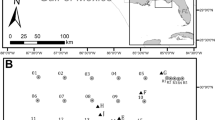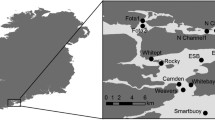Abstract
Demersal fish cannot readily be tracked using satellite-based or light-based geolocation techniques. As an alternative, we describe the tidal location method, which uses tidal data recorded by electronic data storage tags (DSTs), to determine geoposition. Times of high water (H) and tidal ranges (R) recorded by DSTs moored at known locations, and from free-swimming tagged plaice, Pleuronectes platessa, were compared with a North Sea tidal database to identify all positions with matching values of H and R. Within the recording precision of the tag (±0.2 m, ±10 min) and the predicted accuracy of the model generated tidal data (±0.15 m, ±20 min), geolocations over much of the North Sea and eastern English Channel were predicted to be accurate to within 40 km, sometimes to within 10 km. Positional estimates of the moored tags were within 15.7±3.5 km of the actual locations. Geolocations made from tagged plaice within 5 days of release and 5 days pre-recapture were within 35±24 km and 37±23 km of release and recapture positions respectively. Our results demonstrate the ability of this method to accurately describe the migrations of North Sea plaice throughout their geographical range with a level of accuracy unattainable using light-based geolocation. The method could equally be applied to any shelf-dwelling demersal fish that periodically rests on the sea-bed for the duration of a tidal cycle. In fisheries management, the method has clear potential application in defining the movements and migrations of other commercial species.




Similar content being viewed by others
References
Arnold GP, Dewar H (2001) Electronic tags in marine fisheries research: a 30-year perspective. In: Sibert JR, Nielsen JL (eds) Electronic tagging and tracking in marine fisheries. Kluwer, Dordrecht, pp 7–64
Block BA, Dewar H, Farwell CJ, Prince ED (1998) A new satellite technology for tracking the movements of Atlantic bluefin tuna. Proc Natl Acad Sci USA 95:9384–9389
Block BA, Dewar H, Blackwell SB, Williams TD, Prince ED, Farwell CJ, Boustany A, Teo SLH, Seitz A, Walli A, Fudge D (2001) Migratory movements, depth preferences, and thermal biology of Atlantic bluefin tuna. Science 293:1310–1314
Bowden KF (1983) Physical oceanography of coastal waters. Ellis Horwood, Chichester
Boustany AM, Davis SF, Pyle P, Anderson SD, Le Boeuf BJ, Block BA (2002) Expanded niche for white sharks. Nature 415:35–36
Bres M (1993) The behaviour of sharks. Rev Fish Biol Fish 3:133–159
DeLong RL, Stewart BS (1991) Diving patterns of northern elephant seal bulls. Mar Mammal Sci 7:369–384
Dulvy NK, Metcalfe JD, Glanville J, Pawson MG, Reynolds JD (2000) Fishery stability, local extinctions, and shifts in community structure in skates. Conserv Biol 14:283–293
Flather R, Proctor R, Wolf J (1991) Oceanographic forecast models. In: Farmer DG, Rycroft MJ (eds) Computer modelling in the environmental sciences. Clarendon, Oxford, pp 15–30
Freire J, González-Gurriarán E, Bernárdez C (1999) Migratory patterns in the spider crab Maja squinado using telemetry and electronic tags. Int Counc Explor Sea Annu Sci Conf CM1999/AA:14:1–11
Gunn JS, Polacheck T, Davis T, Sherlock M, Betlehem A (1994) The development and use of archival tags for studying the migration, behaviour and physiology of southern bluefin tuna, with an assessment of the potential for transfer of the technology to groundfish research. Int Counc Explor Sea CM1994/Mini:2.1:1-21
Gunn JS, Stevens JD, Davis TLO, Norman BM (1999) Observations on the short term movements and behaviour of whale sharks (Rhincodon typus) at Ningaloo Reef, western Australia. Mar Biol 135:553–559
Hays GC, Adams CR, Broderick AC, Godley BJ, Lucas DJ, Metcalfe JD, Prior AA (2000) The diving behaviour of green turtles at Ascension Island. Anim Behav 59:577–586
Hays GC, Åkesson S, Broderick AC, Glen F, Godley BJ, Luschi P, Martin C, Metcalfe JD, Papi F (2001) The diving behaviour of green turtles undertaking oceanic migration to and from Ascension Island: dive durations, dive profiles and depth distribution. J Exp Biol 204:4093–4098
Hill R (1994) Theory of geo-location by light levels. In: Le Boeuf BJ, Laws RM (eds) Elephant seals population ecology, behaviour and physiology. University of California Press, Los Angeles, pp 227–236
Hill R, Braun M (2001) Geolocation by light level, the next step: Latitude. In: Sibert JR, Nielsen JL (eds) Electronic tagging and tracking in marine fisheries. Kluwer, Dordrecht, pp 315–330
Horwood J, Nichols J, Milligan S (1998) Evaluation of closed areas for fisheries management. J Appl Ecol 35:893–903
Huntley DA (1980) Tides of the north-west European Continental Shelf. In: Banner FT, Collins MB, Massie KS (eds) The North-west European Shelf seas: the sea bed and the sea in motion. II. Physical and chemical oceanography and physical resources. Elsevier, Amsterdam
Jackson JBC, Kirby MX, Berger WH, Bjorndal KA, Botsford LW, Bourque BJ, Bradbury RH, Cooke R, Erlandson J, Estes JA, Hughes TP, Kidwell S, Lange CB, Lenihan HS, Pandolfi JM, Peterson CH, Steneck RS, Tegner MJ, Warner RR (2001) Historical overfishing and the recent collapse of coastal ecosystems. Science 293:629–638
King, M., 1995. Fisheries biology, assessment and management. Fishing News, Oxford
Lutcavage ME, Brill RW, Skomal GB, Chase BC, Howey PW (1999) Results of pop-up satellite tagging of spawning size class fish in the Gulf of Maine: do North Atlantic bluefin tuna spawn in the mid-Atlantic? Can J Fish Aquat Sci 56:173–177
Lynch DR, Ip JTC, Naimie CE, Werner FE (1996) Comprehensive coastal circulation model with application to the Gulf of Maine. Cont Shelf Res 16:875–906
Marshall NB (1965) The life of fishes. Clowes, London
McKibben JN, Nelson DR (1986) Pattern of movement and grouping of gray reef sharks, Carcharhinus amblyrhyncos, at Enewetak, Marshall Islands. Bull Mar Sci 38:89–110
Metcalfe JD (2001) Summary report of the workshop on daylight measurements for geolocation in animal telemetry. In: Sibert JR, Nielsen JL (eds) Electronic tagging and tracking in marine fisheries. Kluwer, Dordrecht, pp 331–342
Metcalfe JD, Arnold GP (1997) Tracking fish with electronic tags. Nature 387:665–666
Metcalfe JD, Arnold GP, Webb PW (1990) The energetics of migration by selective tidal stream transport: an analysis for plaice tracked in the southern North Sea. J Mar Biol Ass UK 70:149–162
Metcalfe JD, Arnold GP, Holford BH (1994) The migratory behaviour of plaice in the North Sea as revealed by data storage tags. Int Counc Explor Sea Annu Sci Conf CM1994/Mini:11:1–13
Metcalfe JD, Hunter E, Holford BH, Arnold GP (1999) The application of electronic data storage tags to spatial dynamics of fish populations. Int Counc Explor Sea Annu Sci Conf CM1999/AA:1:1–7
Musyl MK, Brill RW, Curran DS, Gunn JS, Hartog JR, Hill RD, Welch DW, Eveson JP, Boggs CH, Brainard RE (2001) Ability of archival tags to provide estimates of geographical position based on light intensity. In: Sibert JR, Nielsen JL (eds) Electronic tagging and tracking in marine fisheries. Kluwer, Dordrecht, pp 343–367
Myers RA, Hutchings JA, Barrowman NJ (1997) Why do fish stocks collapse? The example of cod in Atlantic Canada. Ecol Appl 7:91–106
O'Brien C, Fox C, Planque B, Casey J (2000) Climate variability and North Sea cod. Nature 404:142
Pauly D, Christensen V, Froese R, Palomares ML (2000) Fishing down aquatic food webs. Am Sci 88:46–51
Pugh DT (1987) Tides, surges and mean sea-level. Wiley
Righton D, Metcalfe JD, Connolly P (2001) Electronic tags reveal behavioural differences between North Sea and Irish Sea cod. Nature 411:156
Sundermann J (1994) Suspended particulate matter in the North Sea: field observations and model simulations. In: Charnock H, Dyer KR, Huthnance JM, Liss PS, Simpson JH, Tett PB (eds) Understanding the North Sea system. Chapman and Hall, London, pp 45–52
Tuck GN, Polacheck T, Croxall JP, Weimerskirch H, Prince PA, Wotherspoon S (1999) The potential of archival tags to provide long-term movement and behaviour data for seabirds: First results from wandering albatross Diomedea exulans of South Georgia and the Crozet Islands. Emu 99:60–68
Welch DW, Eveson JP (1999) An assessment of light-based geoposition estimates from archival tags. Can J Fish Aquat Sci 56:1317–1327
Welch DW, Eveson JP (2001) Recent progress in estimating geoposition using daylight. In: Sibert JR, Nielsen JL (eds) Electronic tagging and tracking in marine fisheries. Kluwer, Dordrecht, , pp 369–383
West GJ, Stevens JD (2001) Archival tagging of school shark, Galeorhinus galeus, in Australia: initial results. Environ Biol Fish 60:283–298
Wilson RP, Grémillet D, Syder J, Kierspel MAM, Garthe S, Weimerskirch H, Schäfer-Neth C, Scolaro JA, Bost, CA, Plötz J, Nel D (2002) Remote-sensing systems and seabirds: their use, abuse and potential for measuring variables. Mar Ecol Prog Ser 228:241–261
Acknowledgements
The authors wish to thank David Righton for the provision of static-rig DST data and sine-wave analysis software, Bob Turner for field assistance with the release of DST-tagged plaice, Daniel Gadd for statistical advice, and David Riches for supplementary graphics. The release of DST-tagged plaice was funded by the Department of Environment, Food and Rural Affairs (formerly MAFF), and the Commission of European Communities Agriculture and Fisheries (FAIR) specific RTD programme, PL96–2079, "Migration, distribution and spatial dynamics of plaice and sole in the North Sea and adjacent areas". It does not necessarily reflect their views and in no way anticipates the Commission's future policy in this area. Two anonymous referees made valuable contributions to the final version of the manuscript. This paper is dedicated to the memory of Bruce Holford who played an important role in the development of many of the ideas and methods described in this work.
Author information
Authors and Affiliations
Corresponding author
Additional information
Communicated by J.P. Thorpe, Port Erin
Rights and permissions
About this article
Cite this article
Hunter, E., Aldridge, J.N., Metcalfe, J.D. et al. Geolocation of free-ranging fish on the European continental shelf as determined from environmental variables. Marine Biology 142, 601–609 (2003). https://doi.org/10.1007/s00227-002-0984-5
Received:
Accepted:
Published:
Issue Date:
DOI: https://doi.org/10.1007/s00227-002-0984-5




